The European economy is in very poor shape.footnote1 Germany appears to be in recession and growth is at a virtual standstill elsewhere on the Continent. The European Central Bank’s monetary policy is too restrictive while fiscal policy is constrained by the infamous Stability Pact, which is perversely forcing countries to reduce their budget deficits at a time of economic slowdown. Finally, unemployment, already high, is rising again and welfare provisions are progressively being eroded. Against this stands the apparent dynamism of the developed English-speaking world. Quite apart from the remarkable records of Ireland, Australia and Canada (three countries that have witnessed rapid and uninterrupted growth for at least a decade), both the United States and Britain can boast of a very successful economic performance. They seem to have been more resilient to the bursting of the high-tech bubble, have clearly benefited from more flexible macroeconomic policies, and have been at, or close to, full employment for a number of years. It would thus appear that liberal, deregulated market systems function incomparably better than the more consensual, but also much more rigid, Continental economies. And Japan’s dismal performance over the last decade further strengthens this conclusion.
As with all broad-brush pictures, the previous paragraph is right in part, but also contains a number of simplifications, exaggerations and half-truths. For one thing, first-hand impressions are often dominated by recent events and fail to take a longer-run perspective. If this is done, the relative merits and demerits of Anglo-American versus Continental systems are much less apparent. For another, the picture omits to mention that the recent successes of the us and Britain are not fully sustainable. In both countries, the growth in output and the decline in unemployment were in large part driven by an accumulation of household debt that has reduced personal savings to exceptionally low levels. Rising house prices have been one major reason for these trends. As house prices subside and families restore their savings to more normal levels, a sharp slowdown in consumer demand is highly likely.
Yet even taking such a correction into account, the Eurozone’s growth and unemployment performance still looks relatively poor in both a short and medium-term perspective. Indeed, the bursting of America’s borrowing binge could worsen it further. It is not only American families that have over-borrowed, but the us economy as a whole. This has led to what most observers consider to be an unsustainable current-account deficit whose correction will require a substantial weakening of the dollar, a process that has already begun. Dollar depreciation will help the us, by raising both competitiveness and prices—a novel aim now that some countries are in fear of deflation. It will, however, hurt (and is already hurting) a European economy for which exports have been one of the few sources of strength. Weakening competitiveness, in other words, is adding to Europe’s economic problems and is highly likely to continue to do so for the foreseeable future.
This brief paper begins by surveying the comparative record over the last three decades, suggesting that this is much more uniform across the major areas than might be thought. It then examines the usual arguments that have been put forward to criticize the Continental model (and praise the Anglo-American one) and finds that while some are, indeed, valid, particularly in the area of economic policy-making, others are found wanting. It finally provides a brief look into the future which, if only for demographic reasons, looks bound to be less dynamic in Europe than was the past.
Transatlantic comparisons
That Continental European performance has recently been sluggish is undeniable. In the three years that have followed the cyclical peak of 2000, growth may have averaged barely 1 per cent per annum, a record almost worthy of Japan’s 0.5 per cent and well below the nearly 2 per cent growth rates of the United States and Britain.footnote2 Yet, if one takes a somewhat longer view, the picture is not as stark. Table 1 traces the gdp growth record between 1973, the year which many argue marked the end of the postwar ‘Golden Age’, and 2003.
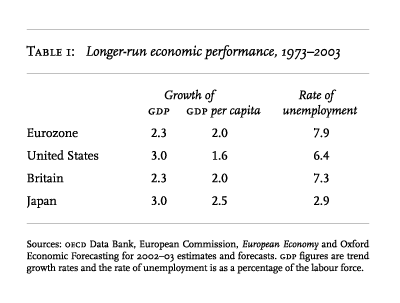
Over these three decades, Eurozone and British growth are the same and not much below those of Japan and the us. The latter’s apparent dynamism, however, owes much to demographic expansion. If population trends are taken into account, the growth of per capita gdp turns out to have been higher in Europe than it was in America. And it is, surely, the rise in living standards that ultimately determines whether countries are, or are not, economically successful.
Three features, however, could modify this conclusion. First, even if per capita gdp has been rising at broadly the same rate throughout the rich world, living standards are still quite different. In particular, Continental Europe (but also Britain and Japan) lag significantly behind the us. Comparisons of gdp per capita made in purchasing power parity, whether by the oecd or the World Bank, suggest that Americans were, in the early years of the twenty-first century, still some 30 per cent richer than Continental Europeans. In other words, one might have expected per capita gdp to have grown a good deal more rapidly in the Eurozone over the last three decades than in the us, as it had done during the ‘Golden Age’, so as to pursue a process of gradual catch-up.
Second, not only has there been no significant growth differential in favour of Europe, but over the last decade any such differential has virtually disappeared. While Eurozone growth decelerated, us growth accelerated. This has been true not only for gdp per capita, but also, and more importantly, for the growth rate of labour productivity, the ultimate determinant of living standards. Should such trends continue, as many expect, the gap between the two areas would widen further. Thirdly, Europe’s record is, in addition, blighted by the significantly higher unemployment rate from which it has suffered since the early 1970s, in contrast to its much more favourable ‘Golden Age’ performance. Indeed, Europe’s relative position in this area has progressively worsened. While in the later 1970s and the 1980s, its rate of unemployment was not that different from the Anglo-American one, by the late 1990s and the first years of the new century the gap had become substantial. Thus, in 2000–03 both the us and the uk (as well as Japan) could boast of an unemployment rate, on comparable definitions, of only 5 per cent, while the Eurozone persisted with a jobless rate of as much as 8.5 per cent (and rising).
Of these three problems, it turns out that the first one is the least significant, since the official data may in good part belie reality. Table 2, below, looks in greater detail at the difference in living standards between the us and the Eurozone. It begins by showing the gap in purchasing power parity estimates mentioned above, and then accounts for it by means of a simple identity which allocates this difference to three major factors. First, Europeans are poorer than Americans because fewer of them work. The employment rate—that is, the share of the population that has a job—is notably lower on the Continent than it is in North America (by as much as 15 percentage points). Second, they are also poorer because the workers that are in employment work a significantly shorter number of hours: 15 per cent again. And thirdly, they are poorer because their hourly productivity is lower than that of their counterparts in the United States.
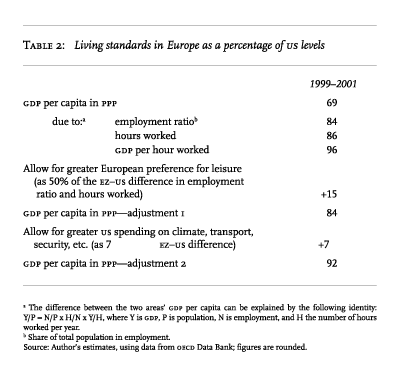
Surprisingly, perhaps, this last factor is not that important. The productivity of an hour’s work turns out to be very similar across the two sides of the Atlantic (though not across the Channel).footnote3 The over-regulated, over-unionized and over-welfarized Continental European worker is actually almost as productive as his or her American counterpart, a finding that must throw into doubt some, at least, of the economist’s conventional wisdom about the great benefits of ultra-liberalism. It is clearly the two labour market features that overwhelmingly lie behind Europe’s lower living standards.
There are several reasons why Europe’s employment rate is below that of America—and of Britain too, for that matter. One is the already mentioned significantly higher unemployment rate in the Eurozone. This, in turn, may also lower the propensity to work among segments of the population discouraged by the likely difficulty of finding a job. And fewer people may be working because of mistaken attempts on the part of governments in a number of countries to encourage early retirement so as to keep the unemployment count down. These various features clearly point to an unsatisfactory functioning of labour markets in Europe compared to America. Two other elements, however, must also play a role. One is Europe’s somewhat less favourable demographic structure, with a higher share of the population aged 65 or more.footnote4 The other is—or at least could be—a greater preference, on the part of women in particular, for less work and more leisure. It is a moot point, of course, how much of this greater preference is voluntarily chosen and how much is imposed by the absence of work opportunities, alternative childcare facilities or other obstacles. Yet, given that publicly financed nurseries, for instance, are a good deal more widespread on the Continent than they are in the United States or Britain, some at least of the lower labour supply may well reflect a conscious choice. In so far as this is the case, while measured living standards would be negatively affected, underlying welfare should not be.
Turning to working hours, Europe’s lower levels are also bound to reflect a mixture of regulation and free choice. The length of the working week is significantly shorter in many European countries because governments may have tried to restrict it. The ill-advised imposition by the former French government of a 35-hour week is the most glaring example of such interference, no doubt welcomed by some workers, but not by all. Interestingly, a similar proposal was put forward by the Italian government in the late 1990s but was then promptly shelved, with the virtually unanimous support not only of politicians and employers, but also of the country’s trade unions. Yet, as so many negotiations on employment conditions have shown, European workers do appear to have a much stronger preference for shorter working hours and longer holidays than do their American or British counterparts. In this instance, too, therefore, the lower measured living standards that shorter working hours produce may, at least in part, not have a corresponding negative effect on people’s welfare.
Trying to split Europe’s lower work effort, in terms of both lower participation in the workforce and fewer hours worked, into a willingly chosen component of a greater preference for leisure and a government or institutional component of greater regulation and involuntary idleness, would seem to be impossibly difficult. The importance so often given to working hours in union negotiations on the Continent militates for an adjustment that privileges a different work–leisure preference. This author’s admittedly totally arbitrary split allocates half of the variation between American and European work patterns to such a choice, as well as to the difference in demographic structures. As a result, an adjusted welfare comparison would suggest that the gap in living standards between the two areas is of the order of perhaps 15 rather than 30 per cent.
American living costs
Even this gap could realistically be reduced, along the lines recently suggested by the American economist, Robert Gordon.footnote5 Looking at us and European spending patterns, Gordon plausibly argues that Americans are actually forced to devote more of their expenditure to things that Europeans do not need to the same extent. He points, in particular, to climate, transport and security. The more extreme meteorology of North America means that, to achieve similar levels of comfort to those in Europe, more needs to be spent on heating and cooling. This boosts gdp but clearly not welfare relative to European levels. Similarly, lack of public transport forces Americans to spend a great deal more than Europeans on car journeys to and from work. Finally, higher levels of crime in the us generate greater public and private spending on security measures. To this list, the present author would also add the greater litigiousness of American society, compared to the higher level of trusts prevalent in Europe, in part thanks to the longer-term relationships fostered by a different system of corporate governance. This too adds significant layers of expenditure on legal services which boost American gdp but, arguably, not only do not add value, but possibly subtract from it.
This list could no doubt be extended and there may, of course, also be examples going in the opposite direction. How to quantify these various factors is, again, impossibly difficult. Gordon provides a very rough estimate that argues for a 7 to 8 per cent adjustment to America’s gdp relative to that of Europe. It is this stab that is incorporated in Table 2. The final figure that is obtained thus suggests that the difference in living standards between the United States and Continental Europe, once allowance has been made for a greater preference for leisure and for ‘unnecessary’ spending in America, is of less than 10 per cent, and could even be close to zero, compared to the 30 per cent gap provided by the official figures. It is true that this high average living standard is marred by the presence of a significantly higher rate of unemployment, but then in the us a similarly high living standard conceals a shocking degree of income inequality.footnote6 And, as was plausibly argued by Ralf Dahrendorf, ‘I for one would probably prefer to be unemployed in Europe than be poor in America’.footnote7
Continental depression
The preceding section has argued that if somewhat arbitrary, but hardly implausible, adjustments are made, Eurozone citizens are virtually as rich as are Americans. Yet it remains true that the Eurozone’s economic record has been far from satisfactory in recent years when compared to that of the us and Britain. Three features in particular were stressed: a much higher rate of unemployment and significantly lower growth rates of both output and productivity. Table 3 illustrates this and points to the growing gap in performance between the Eurozone (and Japan) on the one hand, and the Anglo-American economies on the other, particularly in the 1990s and in the early years of this century.
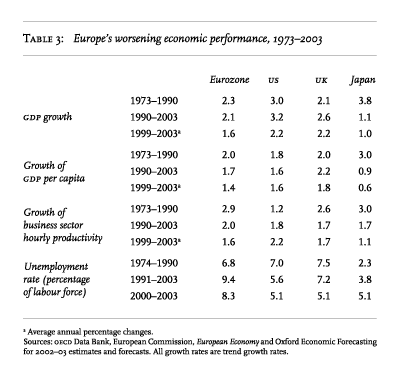
One potential reason for such diverging trends can be readily dismissed. The Eurozone has not, until very recently, suffered from declining international competitiveness. On the contrary, it is the dollar that has appreciated in the second half of the 1990s, as has the pound, while the Euro (or the currencies that preceded it) have fallen as shown in Figure 1, below. This picture is now changing quite rapidly; but for the recent past, at least, Europe’s unsatisfactory record must have been caused by other forces. Two major ones have often been put forward by economists. The first, coming from the orthodox, or neo-classical, wing points an accusing finger at the alleged rigidities of Europe’s institutions—at its web of constraining regulations, at its far too generous and open-ended welfare benefits, at its conservative trade unions—and contrasts this with the nimble, agile, de-regulated economies of Britain and North America. At the opposite side of the (economist’s) ideological spectrum, observers in the Keynesian mould see restrictive macroeconomic policies as the main culprit. The fiscal deflation imposed by the tight criteria that had to be met in order to satisfy the Maastricht Treaty’s conditions for joining European Monetary Union, plunged the Eurozone into slow growth through much of the 1990s. The overcautious monetary policy followed by the ecb since the start of emu, and the absurd constraints imposed on fiscal policy by the eu’s Stability Pact, have kept the area in low growth since then. Both of these explanations contain elements of truth, but neither is fully satisfactory.
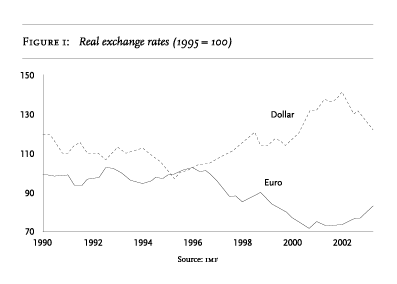
Over-regulated?
It would seem difficult to put most of the blame for Europe’s unsatisfactory labour-market record on restrictive policies curbing the growth of output and hence of employment. No doubt, a more expansionary stance would have had some positive impact, but it still remains true that from cyclical peak to cyclical peak—at times, in other words, when growth was rapid—unemployment rose in the Eurozone. Thus, in 1972–73 it stood at some 2.5 per cent of the labour force, in 1979–80 at 5.5 per cent, in 1989–90 at 8 per cent and in 1999–2000 at 9 per cent (contrast this with the us which saw unemployment going in the opposite direction: from 6.5 per cent in the late 1970s, to 5.5 per cent in the late 1980s, to only 4 per cent during the last boom). Indeed, the wide variety of Europe’s unemployment experiences supports this general point. Growth was weak over most of the Continent, yet countries such as Austria, Norway or Switzerland can today boast of unemployment outcomes better than those of the United States, while in countries such as Greece or Spain unemployment rates are in double digits.
Differences in institutions appear to be a more likely cause and, among these, excessive regulatory restraints could play a role. Labour market protection, in particular, is much more pronounced in France, Germany, Italy or Spain than it is in the us or uk, and some of its features are likely to have inhibited the growth of employment.footnote8 Comparative research in this area, not all of which is ideologically tainted, has also pointed to the unemployment boosting effects, not so much of generous unemployment benefit systems per se, but of ‘unemployment benefits that are allowed to run on indefinitely, combined with little or no pressure on the unemployed to obtain work’.footnote9 And the same research has suggested that high taxes impinging on labour have also played a negative role. Unions, on the other hand, despite much economic conventional wisdom, need not contribute to high unemployment. Much depends on how wages are negotiated. Coordinated bargaining across the whole economy, for instance, can well be very beneficial.footnote10
Indeed, two of the most successful Eurozone economies over the last decade, Ireland and the Netherlands—neither of which, and especially not the latter, are models of unfettered liberalism—owe much of their spectacular results in reducing unemployment from erstwhile very high levels to precisely this factor: coordinated wage rounds. Both countries, by engaging in that ultimate corporatist sin, incomes policies, agreed upon by the various social partners, achieved rapid output growth, a strong profit and competitive performance, and also rapid rises in employment levels and in real wages.footnote11 Conversely, New Zealand, a country that, far from sinning, fulfilled with almost religious fervour all the orthodox prescriptions of labour market deregulation, had a macroeconomic and employment performance that can, at best, only be described as mediocre.footnote12
What all this suggests is that no single factor can fully account for the wide variety of unemployment performances across Europe. In some cases, institutional rigidities and labour-market restrictions may have been at work, as orthodox theory suggests. In other cases, however, similar rigidities have co-existed with much better labour market outcomes. And this is indirectly confirmed by the absence of strong statistical relationships between most standard measures of labour-market regulation and performance.footnote13 These are often weak or non-existent, and cannot justify the strong policy recommendations in favour of unfettered deregulation that international organizations such as the oecd have been preaching for years.
Macroeconomic restraints
The view that excessively restrictive macroeconomic policies have stifled Eurozone growth looks more attractive. In the recent past, the ecb’s continuing, yet clearly outdated, concern with inflation—let alone the pro-cyclical workings of fiscal policy in countries such as Germany or Portugal—stand in marked contrast to the much more flexible action of the American and British central banks and the expansionary tax and expenditure policies followed by those countries’ fiscal authorities. Yet even here, the picture is not quite as clear-cut. As argued earlier, Europe’s lag predates the last few years. Throughout the 1990s, when both the us and Britain were growing rapidly, macroeconomic policies were probably not that different.
Quantifying economic policy stances is not easy. Table 4, below, looks at three rough measures. The top part shows oecd estimates of changes in the structural budget balance, an indicator that abstracts from the effects of cyclical fluctuations on government taxes and expenditures. As will be seen, fiscal consolidation was pursued through the 1990s not only in the Maastricht-constrained Eurozone countries, but also in Britain and, particularly, in Clinton’s America. Only Japan was a clear exception and few would argue that that country’s expansionary fiscal policies were a resounding success. Turning to monetary policy, the table shows the behaviour of nominal short-term interest rates—the instrument directly in the hands of the authorities. Here the data would suggest that the Eurozone and Britain too, for that matter, have consistently been more restrictive than the United States. Yet what really matters to economic activity is the behaviour of real interest rates (net of inflation). The imperfect estimates that are presented for this variable indicate that in this instance, too, the differences between the monetary policy stances of the various areas under consideration were relatively small through the whole of the 1990s.footnote14 Real interest rates, at 4 to 4.5 per cent, were high everywhere, although Japan is, again, a partial exception.
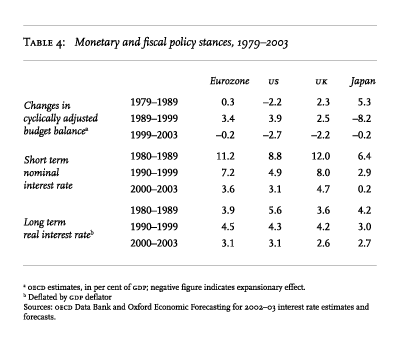
It is true, however, that if one turns to the early years of this decade, the differences are more marked. Monetary and fiscal policies have become clearly expansionary in both Britain and the United States, while this has hardly been the case in the Eurozone, particularly on the fiscal front: and this despite a much more sluggish economic picture. Simulations made on the macroeconomic model of Oxford Economic Forecasting suggest that if Continental Europe had followed America’s monetary policy and had taken some liberties with the Stability Pact, its growth in 2001–03 would have been twice as rapid as it actually was.footnote15 Rather than the 1 per cent per annum recorded, growth would have been at 2 per cent, while budget deficits, thanks to a more rapid expansion of the tax base, would have widened only marginally. Faster growth would also have reduced unemployment this year to some 7.5 per cent of the labour force instead of the expected nearly 9 per cent level. These are significant differences.
Europe’s decelerating productivity
The most worrying aspect of the Continent’s sluggishness has been the slowdown in productivity growth shown below, in Figure 2. It is in this area that one might have expected the orthodox approach to be vindicated. The variations in regulatory regimes must surely be one of the major reasons for differences in efficiency. Yet as was shown above, productivity levels are quite similar across the Atlantic despite very dissimilar institutional set-ups. And these arrangements would seem to be even less responsible for differences in productivity growth rates. After all, throughout Europe the last 10 to 15 years have seen a crusade in favour of deregulation. Free trade has been promoted by, inter alia, the 1992 programme, controls on capital movements have been abolished and the emu’s capital market has been, at least partially, deregulated. In addition, and depending on country, unemployment and other welfare benefits have been cut, trade union power has declined, private pension provisions have been introduced or strengthened, taxes on labour have been reduced, bureaucratic impediments to flexible shop openings, to business creation, or to atypical forms of employment (for example part-time or temporary) have been eased. In other words, Continental Europe has actually come closer to the Anglo-American model and this, if the orthodox view is right, should have led to faster rather than slower growth.
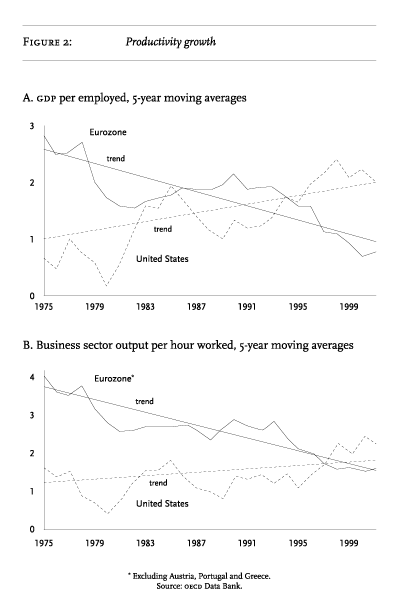
Almost paradoxically, in fact, the slowdown in Europe’s productivity growth is in part due to precisely the deregulation that so many liberal economists keep advocating as the surest way out of Eurosclerosis. By loosening some labour market regulations, this process, to give it its due, has encouraged hiring in numerous European countries—France and Spain, as well as the Netherlands, are the most obvious examples. That, in turn, by raising employment, often in service sectors in which productivity grows rather slowly or is very difficult to measure, has lowered the growth of output per worker. Employment gains have been traded off for productivity ‘losses’. However welcome the first of these effects is, it stands in sharp contrast to the experience of the us economy, which has been able both to create numerous jobs and raise its growth rate of productivity.
It is here that a faster growth rate of overall output would have helped. Had reforms been accompanied by the more expansionary policies that were incorporated in the simulation described above, it is not impossible that Europe’s gdp and employment performance over the last few years could have matched that of Anglo-America. Yet the reforming zeal was accompanied by a stubborn belief that financial orthodoxy, on both the monetary and fiscal fronts, would deliver the nirvana of stable non-inflationary growth. It delivered instead semi-stagnation, rising unemployment, falling profits and the threat of deflation, while allowing a boom and bust stock-market bubble that was even larger, in proportionate terms, than its Wall Street equivalent. In many ways, Continental Europe has abdicated its responsibilities for macroeconomic policy, in sharp contrast to both American and Japanese practices. Seen from the outside, the Eurozone looks almost like a developing country on which the imf has imposed one of those rigid stabilization programmes for which it is so famous: low inflation, fiscal rectitude, deregulation and privatization, all run by a bunch of non-elected officials (Duisenberg, Solbes, Monti and Bolkestein).footnote16
Global competition and ‘new’ economy
Yet, the recent past’s overly restrictive policies, however damaging, cannot fully explain a medium-term deceleration in productivity growth. Had output growth been faster it is possible that, through a relationship much discussed in the 1950s and 1960s and known as ‘Verdoorn’s Law’, there would have been a positive feedback onto productivity growth. Since, however, this relationship applies primarily to the manufacturing sector, it is likely to have lost much of its force in today’s economies, in which industry’s weight is rapidly declining. More importantly, however, it was pointed out above that over the 1990s as a whole, policy stances were not that different between the United States and the Eurozone, yet productivity performance was. Forces other than excessively restrictive policies, or an ongoing process of deregulation, must lie behind Europe’s worsening performance in this area.
One possible factor may be linked to the process of globalization. The surge of East Asian, and especially Chinese, manufactured exports has been largely beneficial for developing and developed countries alike, but it has also accelerated deindustrialization everywhere in the oecd area. This decline in manufacturing production has reduced the share in the economy of the sector with the most rapid growth in productivity. Since this sector was (and still is) much larger on the Continent and in Japan than in the United States, the impact was bound to be felt more severely in the Eurozone economies. And this is the more so as import penetration from China actually increased somewhat more rapidly in these economies than it did in either the us or Britain.
A second force that may also have been at work in opening a gap between American and European performance may, paradoxically, have been the ‘new economy’ revolution. Behind all the hype that fed the unsustainable stock-market bubble, there nonetheless lies some reality. The new information and communication technologies have the power to improve productivity performance and have almost certainly done so, at least in certain sectors. Yet it does appear that, largely for institutional reasons, such successes have been much more prominent in the us than in Europe or Japan. One reason for this lies almost certainly in the much greater ease with which new companies can be created in America, in contrast to the countless bureaucratic restrictions that plague the Continental economies.footnote17 Another is the difference in financial systems. Complex inter-firm, or firm–bank, relations, with multitudes of stakeholders, seem ill-suited to financing industries subject to rapid managerial and technological changes and to high levels of uncertainty.footnote18 Europe’s financial institutions, centred on conservative banks, have, as in the past, preferred to go on lending to their long-established clients, active in traditional sectors. These are often large enterprises that provide secure collateral in the form of buildings and equipment, in contrast to the small firms of the Silicon Valley variety whose main collateral is provided by human capital.footnote19 By contrast, a major force stimulating the development of such new technologies in North America has been the flexibility of financial markets and, in particular, the availability of venture capital.
Older and slower?
Thirdly, demographic trends have also played their role. Demography may be slow moving, but its impact on economics is profound. Trends in both total population levels and in the share of the population that is old are illustrated in Figure 3, below. The contrast between the demographic dynamism of the United States and the demographic stagnation, and coming regression, of the Eurozone and Japan are startling, with Britain somewhere in between, but a lot closer to the Continental than to the American model. A stagnant or falling population reduces growth directly because less labour is available than otherwise would have been the case. An ageing population does the same and is, in addition, also likely, other things equal, to have lower savings than a younger one. This, in turn, is bound to slow down capital formation and hence productivity growth.
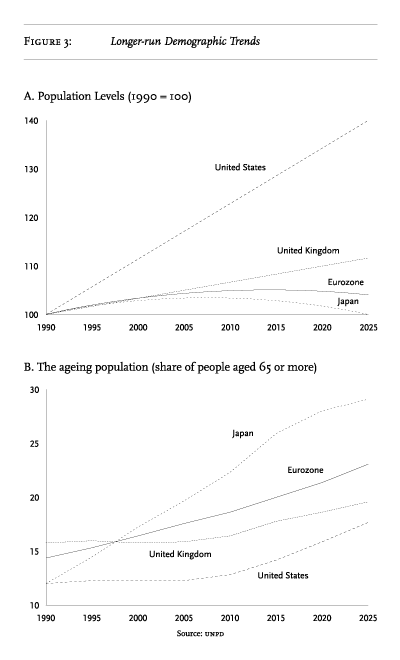
Ageing is also likely to create potential tensions between generations, if pension arrangements for the old are felt to be too generous. Trying to reduce such arrangements, as is increasingly being done, has, moreover, counter-productive effects since it encourages fear and retrenchment among the elderly, thereby slowing down the growth of consumption and accelerating early retirement. Pension reforms are, indeed, necessary. But rather than just pushing for private provisions (something that on the Continent is, as yet, mercifully limited) and cutting the generosity of public benefits, much more effort should be directed at preventing early retirement and encouraging continuing labour-force participation among the aged.
Finally, and in this author’s view most importantly, ageing has a longer-run, indirect negative effect on the growth of both output and productivity of a non-economic nature. Old people are, on the whole, opposed to change and dislike new ventures. Old people are surely less innovative and less entrepreneurial than the young. Thus, America’s advance in the new technologies may also have been helped by the relative youth of its population (both native and immigrant). Europe, in other words, may be slowly turning into a conservative continent, in which a growing share of the population shuns change and frowns on new initiatives. At one level, this is hardly tragic. Welfare levels are high and ageing is associated with a number of favourable aspects (less crime and less pollution, just to mention two obvious ones). At another, however, it does mean that the gap in living standards between the two sides of the Atlantic, however small at present, will almost certainly grow again. And as that gap expands, so too will the political one. America’s superpower position looks set to rise well beyond its present, already overwhelming, status.
Results and prospects
Exactly a decade ago, surveying the economic record of the 1980s and early 1990s, the present author argued that ‘two major problems have beset the Western European economy in the 1980s—a relatively slow growth rate and, more importantly, massive and rising unemployment in most countries of the area’. The reasons for this poor performance were attributed to ‘unfavourable exogenous shocks . . . overly restrictive policies [and] a possible gradual loss of international competitiveness’.footnote20 Sadly, ten years later, neither the picture nor the diagnosis have changed much. Overly restrictive policies have stifled growth, particularly in the early years of this century. Negative shocks have been less in evidence, though German unification did bring with it a number of unfavourable consequences, and the new technology bubble seems to have been associated with greater costs and far fewer benefits than in the us. The lack of international competitiveness was not as important a factor on this occasion—though it looms ahead—and unemployment did not go on rising; but growth performance has deteriorated further in both absolute and relative terms, and this in an environment that has seen rapid technological progress and hence a potential for faster, not slower, productivity growth.
Expectations at the time were that ‘the problem could well worsen in the 1990s as most European economies strive to meet the virtually unattainable fiscal policy targets enshrined in the Maastricht Treaty for monetary union’. Expectations today are no more favourable. The policy-makers have, for twenty years now, been repeating the mantra that price stability and fiscal responsibility, together with market-friendly microeconomic reforms, will put Europe back onto a path of rapid growth and restore full employment. Inflation has been decelerating for fifteen years and is now so low that in some countries there is fear of deflation; budget deficits have been brought under broad control and liberalization efforts have been pursued virtually everywhere. Yet the hoped for successes have hardly come. Persisting with macroeconomic orthodoxy seems hardly to have greatly encouraged business confidence. And market-friendly microeconomic reforms, while appropriate in some areas (for instance bureaucratic over-regulation), may well have had negative effects on consumer confidence in others (such as too rapid an erosion of welfare provisions).
This latter development is particularly worrying for two major reasons. First, welfare states represent an insurance mechanism against economic shocks. Such shocks can become more frequent as globalization proceeds and it is probably no coincidence that welfare provisions are more developed the more countries are open to international trade.footnote21 Few economists doubt the potential gains that can come from continuing globalization—indeed, this is one of the few areas that could stimulate Eurozone growth in future. But to ensure such gains, globalization must also receive legitimacy through popular support. Reducing social security provisions just when the need for them may be increasing hardly seems wise.
Secondly such reductions are bound to generate even more cautionary behaviour among the elderly whose weight is rising rapidly in Continental Europe. As it is, this demographic transformation is bound to reduce growth even further. It is true that many of today’s welfare provisions seem extravagant in the light of these demographic trends, and some indeed are.footnote22 But blanket attempts to pare them, by reducing demand and hence growth, can only worsen any future financing difficulties. It would surely be better for the Eurozone countries to try purposefully to foster growth via a more relaxed macroeconomic policy stance than to persist in niggardly attitudes designed to ensure book-keeping balances. By depressing confidence, such policies are ultimately likely to depress growth as well, even beyond what ageing will, unfortunately, achieve on its own.